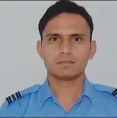Translate this page into:
Aviation Quiz

Compiled by: Shivaling Patil, Institute of Aerospace Medicine, Indian Air Force, Bengaluru, Karnataka, India. Email id: Shivalinga91@gmail.com
Q.no. 01: Time of useful consciousness (TUC) is
Occurrence of hypoxic insult on exposure to altitude
Time available to recognize the development of hypoxia and to take timely corrective actions
Time from commencement of flight until hypoxic effects compromise a pilot’s performance
Several minutes of available emergency oxygen supply to prevent hypoxia
Q.no. 02: Military aircraft are equipped with this type of pressurization system
Isobaric system
Isobaric differential system
Both of the above
None of the above
Q.no. 03: In commercial aircraft, cabin pressure is maintained at
Mean Sea Level {MSL}
Below 5000 feet
Between 6000 to 8000 feet
Above 8000 feet
Q.no. 04: Smoking makes an individual more liable to suffer from hypoxia due to
False statement: Smoking does not make anyone susceptible to hypoxia
Binding of hemoglobin with the carbon monoxide present in the smoke
Effect of nicotine on the nervous system
Smoking affects only those with weak lungs
Q.no. 05: The latitude of earth at which International Civil Aviation Organization standard atmosphere is described is
Equator
23.5 degrees North
45 degrees North
45 degrees South
Q.no. 06: In vivo marker of active oxygen products with Hyperbaric Oxygen Therapy (HBOT) is
Increased urine creatinine
Increased serum acetylamine
Increased urine methyl guanidine
Decreased serum creatinine
Q.no. 07: Hazard Analysis and Critical Control Point was originally designed by
FAA
RFSA
NASA
FDA
Q.no. 08: Pilots give what name to Universal Time Coordinated (UTC)
GMT
Zero hour
Zulu time
Prime time
Q.no. 09:The angle of attack at which an airplane wing stalls will
Change with an increase in gross weight
Remain the same regardless of gross weight
Increase if the Centre of Gravity is moved forward
None of the above
Q.no. 10: “Chibis” Suit is a
Launch and Re-entry Suit
Cooling Garment
Lower Body Negative Pressure Suit
Extra Vehicular Activity Suit
Q.no. 11: What is the percentage of oxygen in the atmosphere at 33,000 ft
21%
25%
30%
35%
Q.no. 12: How many revolutions does the International Space Station make around the Earth in a day
12
14
16
18
Q.no. 13: In the Apollo 11 mission, what was the name of Command Module
Eagle
Columbia
Challenger
Endeavour
Q.no. 14: You are hiking with a friend and reach an elevation of 10,000 feet. You pitch your tents and go to sleep. In the morning, your friend reports a headache, then begins complaining of difficulty breathing, even at rest. What would be the best action to take for your friend
Give your friend some coffee, as he is most likely experiencing a caffeine headache
As quickly as possible, descend to a lower elevation with your friend
Advise your friend to relax, as he is most likely stressed out from spending a night on a mountainside
As quickly as possible, climb higher, as the air at higher elevations contains more oxygen
Q.no. 15: Which of the following aircraft disinfecting agents is biologically effective and safe for passengers
Dichlorodiphenyltrichloroethane-10%
Benzene Hexachloride-5%
Resmethrin-2%
Baygon-20%
Q.no. 16: The first physician to go into space was
Yuri Gagarin
Yegorov
Armstrong
Kerwin
Q.no. 17: North Atlantic Treaty Organization reporting name of Mikoyan MiG 29
Frogfoot
Fulcrum
Fullback
Fritz
Q.no. 18: Aircraft carrier Known as “Grand Old Lady”
INS Vikrant
INS Vikramaditya
INS Asvini
INS Viraat
Q.no. 19: The first indigenous fighter aircraft of India designed and built by Hindustan Aeronautics Limited
HF 25 MKI
HT 2
HT 3 MKI
HF 24
Q.no. 20: The blade twist in the propeller helps
Even out the thrust along the length of the blade
Reduce noise levels
Make propelling easier
Increase the friction between the blades
Q.no. 21: The vertical flight of a helicopter is controlled by
Increasing or decreasing the RPM of the main rotor
Cyclic pitch changes
Collective pitch changes
Any of the above
Q.no. 22: Chicken gun refers to
Emergency landing due to a flock of birds
Shooting bird carcasses to airplane engines
A bird dies in airplane engine
Weapon systems in aircrafts
Q.no. 23: Airborne Rescue Pod for Isolated Transportation by Indian Air Force is a system for
Transportation of injured soldiers in field
Rescue system for people affected by flood
Transportation of COVID patients
Search & rescue in aircraft accidents
Q.no. 24: Name given to specially designed aircraft used by US President.
Air force America
Air force Omega
Air force Elect
Air force One
Q.no. 25: A common cause of foodborne illness inflight is due to
Delay in serving meals
Infected food handler
Improper holding temperatures
Both (b) and (c)
Q.no. 26: Full form of MARS in aviation
Maintenance and Repair System
Mild Air Refueling System
Main Aviation Resource System
Main Rotor Restart System
Q.no. 27: First IAF Helicopter formation display team
Sarang
Suvarna
Suryakiran
Dhruv
Q.no. 28: The first aircraft to be fitted with a rocket-propelled seat was
F-16 Delta Dart
Gloster Meteor MK III
Lockheed M-21
F-102 Delta Dagger
Q.no. 29: What happens to the central venous pressure immediately on entering microgravity
Increase
Decrease
Remains same
None of the above
Q.no. 30: Who was the first woman in space
Svetlana Savitskaya
Valentina Tereshkova
Sally ride
Mae Jemison
Answers to the Aviation Quiz
Solutions: 1 (b), 2 (b), 3 (c), 4 (b), 5 (c), 6 (c), 7 (c), 8 (c), 9 (b), 10 (c), 11 (a), 12 (c), 13 (b), 14 (b), 15 (c), 16 (b), 17 (b), 18 (d), 19 (d), 20 (a), 21 (c), 22 (b), 23 (c), 24 (d), 25 (d), 26 (b), 27 (a), 28 (d), 29 (b), 30 (b).





